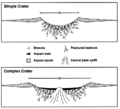Obolon' crater
Obolon' crater is a 20 km (12 mi) diameter buried meteorite impact crater situated about 200 km (120 mi) southeast of Kiev in Ukraine (Poltava Oblast).[1][2] The site has been drilled, which revealed the presence of shocked minerals and impact melt rock; the high chlorine content of the latter suggesting that the area was covered by shallow sea at the time of impact.[3] One estimate puts the age at 169 ± 7 million years (Middle Jurassic).[4]
Hypothetical multiple impact event
It has been suggested by Geophysicist David Rowley of the University of Chicago, working with John Spray of the University of New Brunswick and Simon Kelley of the Open University, that Obolon' may have been part of a hypothetical multiple impact event which also formed the Manicouagan crater in northern Quebec, Rochechouart crater in France, Saint Martin crater in Manitoba, and Red Wing crater in North Dakota. [5] All of the craters had previously been known and studied, but their paleoalignment had never before been demonstrated. Rowley has said that the likelihood that these craters could be aligned like this due to chance is nearly zero.[6]
References
- ↑ Masaitis, V. L.; A. N. Danilin, G. M. Karpov and A. I. Raikhlin (1976). "Karla, Obolon' and Rotmistrovka astroblemes in the European part of the USSR". Doklady Akademii Nauk SSSR (in Russian) 230: 174–177.
- ↑ Val'ter, A. A.; E. P. Gurov and V. A. Ryabenko (1977). "The Obolon' fossil meteorite crater astrobleme on the northeast flank of the Ukrainian Shield". Doklady Akademii Nauk SSSR (in Russian) 232: 170–173.
- ↑ Gurov E.P., Gurova E.P. (1995). "Impact melt composition of the Obolon crater: chlorine as a possible indicator of the submarine crater formation". Meteoritics, v. 30, p 515. Abstract
- ↑ "Obolon'". Earth Impact Database. University of New Brunswick. Retrieved 2009-08-16.
- ↑ Spray, J.G., Kelley, S.P. and Rowley, D.B. (1998). "Evidence for a late Triassic multiple impact event on Earth". Nature, v. 392, pp. 171–173. Abstract
- ↑ Steele, Diana (19 March 1998). "Crater chain points to impact of fragmented comet". University of Chicago Chronicle
Coordinates: 49°35′N 32°55′E / 49.583°N 32.917°E

